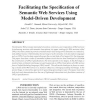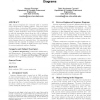35 search results - page 5 / 7 » Semantics of interactions in UML 2.0 |
ESAW
2000
Springer
13 years 11 months ago
2000
Springer
Abstract. Software engineering describes a system at different levels of abstraction. Agent-oriented software engineering introduces a new level, called the agent level, to allow t...
JWSR
2006
13 years 7 months ago
2006
The Semantic Web promises automated invocation, discovery, and composition of Web services by enhancing services with semantic descriptions. An upper ontology for Web services cal...
ICSE
2005
IEEE-ACM
14 years 7 months ago
2005
IEEE-ACM
UML sequence diagrams are commonly used to represent object interactions in software systems. This work considers the problem of extracting UML sequence diagrams from existing cod...
JUCS
2006
13 years 7 months ago
2006
Abstract: UML may be used to describe both the structure and behavior of objectoriented systems using a combination of notations. For the modeling of the dynamic behavior, a number...
ISORC
2000
IEEE
13 years 11 months ago
2000
IEEE
The Unified Modeling Language UML is well-suited for the design of real-time systems. In particular, the design of dynamic system behaviors is supported by interaction diagrams an...


